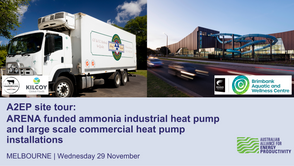
USING HEAT PUMPS FOR AQUATIC CENTRES
As energy audits consistently show, there are a number of things aquatic centre managers can do to make their facilities more efficient, including optimising pool pumps, upgrading lighting and increasing the understanding capacity of the people operating the facility. However, improving the efficiency and productivity of the pool water heating and of heating and cooling the facility will offer the greatest benefits for long term cost savings and also offer a transition path for councils and facilities wishing to move away from gas use as part of emission targets. Heat pumps operate using electricity, so they facilitate a move away from using gas and to fully utilising on-site renewable energy generation and through the purchase of renewable energy, for example through power purchase agreements (PPAs).

ABOUT HEAT PUMP TECHNOLOGY
Quite simply a heat pump is a device that uses a low amount of energy to move thermal energy, or heat, from one place to another, using compressors, condensers and evaporators. Depending on the direction of the process and set-up, a heat pump can either provide cooling by removing heat, or heat a space or liquid. It can even provide heating and cooling at the same time, at even higher efficiency. Heat pumps are found in almost everyone home and business, in the form of refrigerators and split-system air conditioners. At a commercial or industrial scale, heat pumps can heat large spaces and volumes of water, utilising waste heat in the process.
You can learn more about industrial heat pump technologies at this website or in the presentation slides from Alan Pears, below.

WEBINAR: Best practice for heat pumps in aquatic centres
Studies have shown Victoria has around 400 aquatic centres using a combined 3.5PJ/year of natural gas. Heat pumps represent are a high-efficient alternative for water-heating and providing other thermal services within aquatic centres, with the added bonus of being able to utilise on-site solar PV generation.
With support from Sustainability Victoria and the Department of Environment, Land, Water and Planning on behalf of the Victorian Government, A2EP hosted a webinar for Victorian local government officers to share pathways for implementation of heat pumps in aquatic centres, as well as best practice guidelines.
The webinar included insights from technical experts, looking at all aspects of optimising energy use in aquatic centres (and swimming school pools), including addressing the building enveloped and energy efficiency first to how to consider heat pumps to support that is available from programs such as the Victorian Energy Upgrades (VEU) program. As high consumers of energy, and with energy prices rising, aquatic centres are a focus area for supporting electrification.
Presenters for this event:
-
Noy Hildebrand - Revitalising Environments
-
Derek Harbison - Negawatt Projects
-
Dr Jean Jonathan Duverge - Northern Environmental Design
-
Chris Warris - Northmore Gordon
-
Tony Kimpton - TK Thermal
-
Jarrod Leak - A2EP
WEBINAR: Integrating heat pumps into aquatic centres
To assist councils and other operators, A2EP together with Local Government Procurement and Regional Development Australia Sydney hosted a webinar on 12 October 2021 to brief council officers on the opportunities and challenges of implementing heat pump technology in aquatic centres. As well as technology outlines, the webinar included presentations from two Australian councils which have and are about to utilise heat pumps in their aquatic facilities, including the all electric, zero emissions Brimbank Aquatic and Wellness Centre in Victoria. You can watch the webinar below and view the slides from our presenters.
Presenters for this event:
-
Alan Pears AM - RMIT University and A2EP
Download Alan's presentation slides -
Trent Hawkins - Northmore Gordon
Download Trent's presentation slides -
Ian Garradd - North Sydney Council
Download Ian's presentation slides -
Ross Kingston - Brimbank City Council
Download Ross's presentation slides
Key recommendations from our presenters:
-
An energy audit can often identify options for easy and affordably optimisation to tick off before you tackle the big stuff. They can also identify ways you can teach staff to contribute to energy savings by altering behaviours and procedures. If you are considering using heat pumps, seek out an energy consultant with expertise in heat pumps and ideally aquatic centres.
-
Improving the thermal performance of the building fabric is important for delivery improved energy performance and indoor comfort levels.
-
The payback of heat pumps is improving as the imperative to decarbonise grows - and as the cost of gas increases.
-
Plan ahead - start working on your business case now to prepare for replacing existing technology at its end-of-life, if not sooner.
-
Explore funding opportunities through certificate schemes in your state or territory.
Heating-as-a-service
Faced with the technical complexities of moving from traditional boiler systems, the heating-as-a-service model might be an attractive option for councils. The model is expected to grow in popularity as all sectors move to decarbonise. It removes the capital costs of installing technology, instead the customer (councils, in this instance) pays for the service (heating and cooling of water and facilities) provided by a third party which monitors and manages the equipment to deliver the required service for an agreed cost. There are a number of providers in this space in Australia, including Veolia, Flexigen and Air Change.
WEBINAR: Practical guidelines for heat pump installations in aquatic centres
On 21 July 2022, with support from the Victorian Department of Environment, Land, Water and Planning (DELWP - now DEECA), A2EP hosted a webinar offering practical guidelines for installing heat pumps, which included a section case study on using heat pumps in aquatic centres. After some advice from A2EP's Jarrod Leak and Dr Ahmad Mojiri from RMIT University, representatives from the Bridgeford Group and Geelong City Council presented a case study on the implementation of heat pumps at the Kardinia Aquatic Centre in Geelong. You can catch up now with the recording.
Technical Guidelines for Commercial and Industrial Air Source Heat Pump Water Heaters - with a special section on aquatic centre applications
As part of its work for Victorian Department of Environment, Land, Water and Planning, A2EP developed comprehensive technical guidelines for air source heat pumps for water heating applications. The guidelines include special sections on different applications, including aquatic centres. The guide includes a number of aquatic centre case studies.

CASE STUDIES & RESOURCES
-
Kardinia Aquatic Centre, Geelong, Victoria - FutureHeat
-
Doone Kennedy Hobart Aquatic Centre, Tasmania - FutureHeat
-
The all-electric Northcote Aquatic and Recreation Centre - Green Building Council of Australia
Energy upgrade and certificate schemes:
-
NSW Energy Savings Scheme - NSW Department of Planning, Industry & Environment
-
Victorian Energy Upgrades Program - Vic Department of Energy, Land, Water and Planning






















